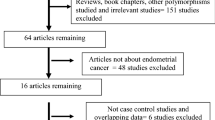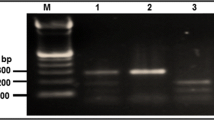Abstract
Objectives
Uterine leiomyomas (ULMs) are estrogen-dependent tumors that are more common in African American women. The etiology for such ethnic disparity is currently unknown. Catechol-O-methyltransferase (COMT) is an essential enzyme in estrogen metabolism. In the current study, we investigated the association of the functional COMT Val158 Met polymorphism with ULM in different ethnic groups. We also studied the biologic role of COMT in tumor formation in human and rat leiomyoma cell lines and the potential therapeutic utility of COMT inhibitors.
Methods
The genotype frequencies of the functional COMT Val158 Met polymorphism among participants with (186 women) or without (142 women) ULMs were compared, as was the differential ethnic distribution of that polymorphism using polymerase chain reaction (PCR) and restriction fragment linkage polymorphism. Proliferation, Western blot, and reporter trans activation analyses were applied to myometrial and leiomyoma cells representative of different COMT genotypes.
Results
Women with the high-activity COMT Val/Val genotype are 2.5 times more likely to develop ULMs than women with other genotypes (confidence interval, 1.017 to 6.151; P <.001). The prevalence of this genotype was significantly higher in African American women (47%) compared with white (19%) or Hispanic (30%) women (P =.003). Myometrial cell lines expressing the Val/Val genotype exhibited significantly enhanced responses to estrogen in proliferation and in estrogen-responsive element reporter assays. COMT-specific inhibitors reversed such a response and induced apoptosis. Myometrial specimens from Val/Val women demonstrated distinct estrogen-regulated gene expression that was consistent with enhanced proliferation and decreased apoptosis.
Conclusions
The high-activity COMT Val/Val genotype is associated with increased risk of ULM. Our results provide a possible explanation for the higher prevalence of ULMs among African American women and offer a potential new target for nonsurgical treatment using COMT inhibitors. (J Soc Gynecol Investig 2006;13:136-44) Copyright © 2006 by the Society for Gynecologic Investigation.
Similar content being viewed by others
References
Cramer SF, Patel A. The frequency of uterine leiomyomas. Am J Clin Pathol 1990;94:435–8.
Rice JP, Kay HH, Mahony BS. The clinical significance of uterine leiomyomas in pregnancy. Am J Obstet Gynecol 1989;160:1212–6.
Marshall LM, Spiegelman D, Barbieri RL, et al. Variation in the incidence of uterine leiomyoma among premenopausal women by age and race. Obstet Gynecol 1997;90:967–73.
Howe SR, Gottardis MM, Everitt JI, et al. Rodent model of reproductive tract leiomyomata. Establishment and characterization of tumorderived cell lines. Am J Pathol 1995;146:1568–79.
Andersen J, DyReyes VM, Barbieri RL, Coachman DM, Miksicek RJ. Leiomyoma primary cultures have elevated tran-scriptional response to estrogen compared with autologous myometrial cultures. J Soc Gynecol Investig 1995;2:542–51.
Balloch EA. The relative frequency of fibroid processes in the dark-skinned races. Med News 1894;2:29–35.
Kjerulff KH, Guzinski GM, Langenberg PW, et al. Hysterectomy and race. Obstet Gynecol 1993;82:757–64.
Amant F, Huys E, Geurts-Moespot A, et al. Ethnic variations in uterine leiomyoma biology are not caused by differences in myometrial estrogen receptor alpha levels. J Soc Gynecol Investig 2003;10:105–9.
Lachman HM, Papolos DF, Saito T, et al. Human catechol-O-methyltransferase pharmacogenetics: Description of a functional polymorphism and its potential application to neuropsychiatric disorders. Pharmacogenetics 1996;6:243–50.
2000 Census of Population, Public Law 94–171 Redistricting Data File. US Census Bureau, 2000.
Day Baird D, Dunson DB, Hill MC, Cousins D, Schectman JM. High cumulative incidence of uterine leiomyoma in black and white women: Ultrasound evidence. Am J Obstet Gynecol 2003;188:100–7.
Kitawaki J, Obayashi H, Ishihara H, et al. Oestrogen receptor-alpha gene polymorphism is associated with endometriosis, adenomyosis and leiomyomata. Hum Rep rod 2001;16:51–5.
Denschlag D, Bettendorf H, Watermann D, et al. Polymorphism of the p53 tumor suppressor gene is associated with susceptibility to uterine leiomyoma. Fertil Steril 2005;84:162–6.
Sambrook J, Fritsch EF, Maniatis T. Molecular cloning: A laboratory manual. New York: Cold Springs Harbor Laboratory Press, 2000.
Al-Hendy A, Lee EJ, Wang HQ, Copland JA. Gene therapy of uterine leiomyomas: Adenovirus-mediated expression of dominant negative estrogen receptor inhibits tumor growth in nude mice. Am J Obstet Gynecol 2004;191:1621–31.
Bradlow LH. 2-Hydroxyesterone: The “good” estrogen. J Endocrinol 1996;150:S259–65.
Vandewalle B. Opposite effects of estrogen and catecholestrogen on hormone-sensitive breast cancer cell growth and differentiation. Mol Cell Endocrinol 1989;61:239–46.
Reddy VV, Hanjani P, Rajan R. Synthesis of catechol estrogens by human uterus and leiomyoma. Steroids 1981;37:195–203.
Liu Z-J, Zhu BT. Concentration-dependent mitogenic and antiproliferative actions of 2-methoxyestradiol in estrogen receptor-positive human breast cancer cells. J Steroid Biochem Mol Biol 2004;88:265–75.
Banerjee SN, Sengupta K, Banerjee S, Saxena NK, Banerjee SK. 2-Methoxyestradiol exhibits a biphasic effect on VEGF-A in tumor cells and upregulation is mediated through ER-alpha: A possible signaling pathway associated with the impact of 2-ME2 on proliferative cells. Neoplasia 2003;5:417–26.
Lippert C, Seeger H, Mueck AO. The effect of endogenous estradiol metabolites on the proliferation of human breast cancer cells. Life Sci 2003;72:877–83.
Michnovicz JJ. Increased urinary catechol estrogen excretion in female smokers. Steroids 1988;52:69–83.
McLeod HL, Fang L, Luo X, Scott EP, Evans WE. Ethnic differences in erythrocyte catechol-O-methyltransferase activity in black and white Americans. J Pharmacol Exp Ther 1994;270:26–9.
Taioli E, Garte SJ, Trachman J, et al. Ethnic differences in estrogen metabolism in healthy women. J Natl Cancer Inst 1996;88:617.
Lavigne JA, Helzlsouer KJ, Huang HY, et al. An association between the allele coding for a low activity variant of catechol-O-methyltransferase and the risk for breast cancer. Cancer Res 1997;57:5493–7.
Mitrunen K. Polymorphic catechol-O-methyltransferase gene and breast cancer risk. Cancer Epidemiol Biomarkers Prev 2001;10:635–40.
Author information
Authors and Affiliations
Corresponding author
Additional information
Supported by a National Institutes of Health grant to A.A-H. (R01 HD46228).
The authors would like to acknowledge J.L. Simpson for review of the manuscript and Ye Wang for excellent technical assistance.
Rights and permissions
About this article
Cite this article
Al-Hendy, A., Salama, S.A. Catechol-O-Methyltransferase Polymorphism Is Associated With Increased Uterine Leiomyoma Risk in Different Ethnic Groups. Reprod. Sci. 13, 136–144 (2006). https://doi.org/10.1016/j.jsgi.2005.10.007
Published:
Issue Date:
DOI: https://doi.org/10.1016/j.jsgi.2005.10.007




